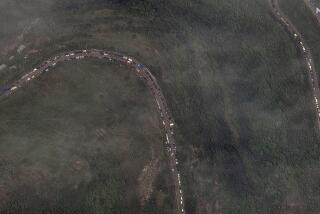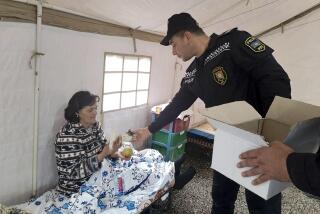Soviets Try to Keep Afghan Lifeline Open : Copters Attack Rebel Forces at Strategic Tunnel
- Share via
KABUL, Afghanistan — Every morning soon after dawn these days, Soviet helicopter gunships lift off from the icy tarmac at Kabul International Airport.
The airborne armada, laden with rockets, banks to the north and climbs off toward the snow-capped Hindu Kush mountain range.
Their destination: the Salang Tunnel, the final battleground for the Soviet Union in its long and bloody struggle in Afghanistan.
Built in the mid-1950s as a Soviet aid project by then-Premier Nikita S. Khrushchev to win support from the Afghans, the 1.7-mile tunnel through the towering Hindu Kush has become the most critical military choke point in the nine-year Afghan war, both for the Soviets as they withdraw the last of their troops from Afghanistan and for Afghanistan’s Soviet-backed President Najibullah.
Main Valve in Lifeline
At 11,100 feet above sea level, the tunnel is the main valve in the lifeline linking the Afghan capital and the Soviet Union, the Salang Highway, which is now the only feasible route for food and fuel entering Kabul from the Soviet Union and the exit for Soviet troops going home by road.
In recent days, though, the tunnel has taken on even more importance. It has become the focal point of U.S. government charges that the Soviets are pursuing a “scorched-earth policy” in a troop withdrawal that the State Department has likened to the U.S. withdrawal from Vietnam.
Speaking to reporters less than 48 hours after he closed the U.S. Embassy in the beleaguered Afghan capital, Charge d’Affaires Jon Glassman described recent Soviet military operations at the tunnel as “a blood bath.”
“All the houses south of the Salang Tunnel were obliterated by artillery,” Glassman said, referring to a massive Soviet ground and air bombardment launched Jan. 23 to protect the strategic tunnel from rebel attacks.
“They just killed innocent people living in those houses.”
Reports from Western diplomats in Kabul three days after the bombardment began were even more graphic. One report quoted eyewitnesses as saying that they saw Soviet tanks “rolling over (the) dead bodies of victims of (the) Salang road.” Hundreds of civilians had been killed there, the witnesses reported.
None of the Western journalists visiting Afghanistan, nor any of the Western diplomats who have been reporting on the war from Kabul, have been allowed to visit the tunnel or the mountain villages to the north or south of it.
During a press conference in Kabul on Tuesday, Lt. Gen. Boris Gromov, the commander of Soviet troops in Afghanistan, conceded that Soviet troops had launched an offensive on rebel positions near the tunnel on Jan. 23.
U.S. Charge Rejected
But Gromov sharply rejected State Department spokesman Charles Redman’s allegation of a “scorched-earth policy” even as he conceded that many civilians had been killed in the effort to clear and secure the tunnel for the departure of Soviet troops. He said four Soviets soldiers were killed in the operation, with 11 wounded.
Western analysts said Gromov’s willingness to discuss the artillery and air bombardment was confirmation of how critical the Salang Tunnel has become as the Soviets try to withdraw the last of their 115,000 troops within the next few days.
Western journalists in Kabul saw a convoy of more than 100 Soviet trucks and tanks starting out along the highway Thursday, according to Reuters news agency.
At the same time, Soviet forces are still moving military supplies in the opposite direction, showing Moscow’s readiness to continue support for the Afghan government. A Reuters correspondent counted 15 Soviet trucks loaded with 24 rockets each as they rolled into Kabul on Wednesday.
In justifying the offensive, Gromov and other Soviet officials have cited the presence in the area of the powerful Afghan rebel commander Ahmad Shah Massoud, who is generally viewed as the most effective and disciplined military leader among the moujahedeen, as the fractious rebel movement is known.
Massoud has received and stockpiled vast quantities of sophisticated American-supplied weapons in recent weeks, and moujahedeen leaders said the commander and his men will be at the cutting edge of the military effort to isolate Kabul after the Soviets leave.
Under U.S. pressure to allow the Soviets to withdraw in peace, the rebel spokesmen insist that Massoud “has shown great restraint” in not attacking Soviet convoys.
But Gromov credited his military operation in the Salang area for the absence of moujahedeen attacks, asserting that Massoud’s rebels suffered huge casualties in the Soviet bombardment.
However, on Thursday, Moscow Radio reported that a Soviet convoy was attacked Wednesday as it moved northward along the Salang Highway not far from Kabul.
“Armed Afghan opposition units have shelled with missiles Soviet troops leaving Afghanistan in keeping with the Geneva agreement,” the radio said. “The convoy was attacked on Wednesday within several kilometers of the city.”
The report did not say how many missiles were fired or if there were casualties.
President Najibullah and Soviet officials have maintained that Afghan government forces will be able to keep the highway and tunnel open even after the Soviet troops are gone, an operation that will be critical in supplying Kabul and keeping Najibullah in power.
Afghan troops, Najibullah said Thursday, are “capable of independently defending the people and the homeland and can give a resolute . . . rebuff to the opposition.”
But Western diplomatic observers, chief among them Glassman, maintained that Massoud’s losses in the Salang campaign were minimal, and they predicted that the commander’s expected operations to seal off Kabul from Najibullah’s Soviet benefactors to the north will help to bring about the fall of the Afghan government.
If Najibullah and his regime are forced out of Kabul, they could retreat to Mazar-e-Sharif in northern Afghanistan, a town that observers see as a fallback position because of its proximity to the Soviet border. But getting there by road would require control of the Salang Highway and tunnel.
Already, Kabul is plagued by severe shortages of food and fuel. Bread lines form outside bakeries before dawn, and Glassman said he saw more than 300 cars in line at a gas station the day he left.
Strategy to ‘Choke Capital’
“Massoud’s strategy will be, choke the capital, spread panic and anger toward the government through the people and the army and hopefully force a coup or a popular uprising against Najibullah,” said one Western diplomat, whose government, like the United States, has favored the moujahedeen .
“When you look at all the warring factions within the moujahedeen, Massoud and his men are the real bright spot. And when you look at the importance of that tunnel, Massoud is the right man in the right place at the right time.”
CHOKE POINT
The 1.7-mile Salang Tunnel through the Hindu Kush is the most critical choke point in the Afghan war. It is:
Only feasible route for food and fuel into the capital.
Only road for Soviet soldiers going home.
It is shaping up as the Soviet Union’s final battleground in Afghanistan.
More to Read
Sign up for Essential California
The most important California stories and recommendations in your inbox every morning.
You may occasionally receive promotional content from the Los Angeles Times.













